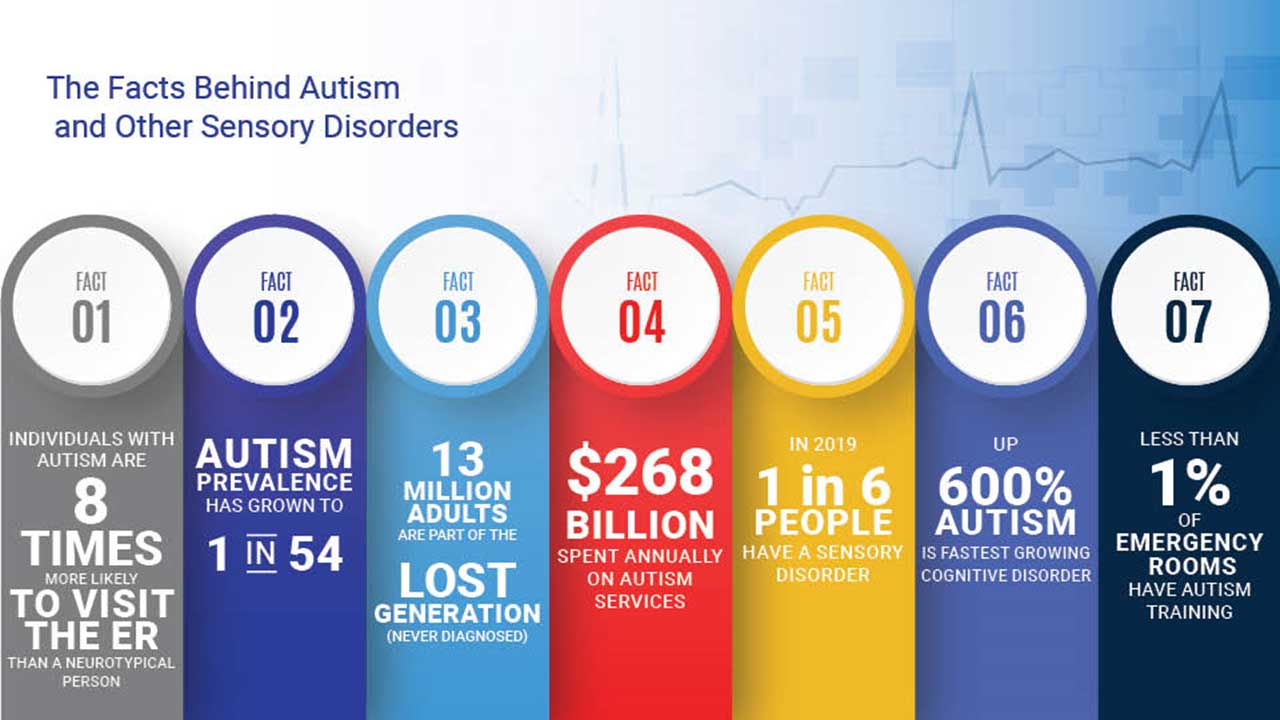
Imagine not being aware that your patient’s pain level is not being accurately communicated. Imagine not knowing that when examining a patient, you may inadvertently cause the visit time to be tripled. Imagine misdiagnosing a serious health issue because your patient communicates differently and did not indicate their concerns the same way a “typical” patient does.
Potential for Misdiagnosis and Increased Visit Time is High
This is the reality for patients with autism who visit emergency departments with urgent or acute medical issues and encounter providers and support staff that are not knowledgeable in the medical differences for people with autism and how to ensure an efficient, effective visit.
Autism-specific training is critical for all staff in EDs to ensure patient sensory issues and communication barriers are reduced or eliminated as patients move through the ED. Millions of people are diagnosed with autism, with millions more going undiagnosed into adulthood.
Autism is not restricted to one socioeconomic level, race or gender and affects a large portion of your community. ED providers are already seeing patients with autism, whether those individuals identify their diagnosis or not, and many more individuals with autism are hesitant to seek out medical care or have had negative experiences due to lack of awareness of their individual needs.
Those With Autism Frequent the ED More
According to the CDC, one in every 45 adults and one in every 44 children are diagnosed with autism in the United States, not to mention the millions of adults who were never officially diagnosed but nevertheless are on the spectrum and have sensory needs.
This rapidly growing population demands proper healthcare and it has been found that those with autism tend to visit the ER more often than those who are not on the spectrum.
Autism is a spectrum disorder that affects each individual differently. The complex nature of ASD means that individuals can have a wide variance of co-occurring disorders, physical and cognitive needs, as well as sensory differences.
The complexity of autism paired with its prevalence and frequent comorbidities make it the perfect storm for all EDs.

EDs are Stressful Environments
For anyone, a trip to the ED is usually stressful and time consuming. However, for someone on the spectrum, this experience can be harrowing.
ASD is a sensory disorder meaning it can make people sensitive to stimulation, which can cause them extreme amounts of stress. This can often be so overwhelming that it causes a meltdown, which is not a tantrum but rather a response to an overstimulating environment that generally needs to run its course. These sensory needs can potentially cause delays or barriers when receiving treatment if providers are unaware on how to best work with these patients.
“There’s a growing need,” said Fareed Fareed, medical director of the emergency department at HealthAlliance Hospital in Kingston, New York. “It’s ensuring you’re meeting the needs of a segment of the population.”
As the demand for quality and timely care for individuals with ASD grows, EDs face their own set of challenges.
Challenges EDs Face
The Seattle Children’s Hospital reported that they see between three to four patients with autism every day in their emergency room.
One of their biggest challenges has been not understanding how to work with these patients due to communication difficulties. Children with autism may have a hard time expressing pain or communicating what is going on. This makes it difficult for parents to understand what their child is going through and even harder for medical staff to determine the issue and proceed with proper treatment.
Another challenge is that those with autism often do not adjust well to unfamiliar environments and they have sensory sensitivities. Most emergency rooms consist of bright lights, loud noises, and many unfamiliar faces.
“Emergency departments are, by design, not great places for individuals with autism or special needs that are in crisis,” said Eric Eberman, public policy director for Autism New Jersey. “They’re loud. There’s not a lot of areas where they can be calm or find space or be treated in a quick manner. I think it’s generally just difficult to begin with.”
Eileen Klein, a doctor at Seattle Children’s Hospital, said “Patients and their families have a lot of issues when they come into the ED. Kids cannot sit still for very long, they need to be in a quiet space, they need to be seen quickly. When families can come into the ED prepared for what is going to happen and knowing what to expect it can make a big difference, although there is no guarantee.”
“General hospitals are not really equipped to handle someone who is autistic,” said Mark De Antonio, director of adolescent inpatient services at Resnick Neuropsychiatric Hospital in Los Angeles. “Several times a month I hear about patients with no immediate care options being medicated and sedated as they’re held. It’s a huge problem.”
“As more children with autism are identified, and as the population is growing larger and older, we see a lot more mental health needs in children and adolescents with autism,” said Aaron Nayfack, a developmental pediatrician at Sutter Health’s Palo Alto Medical Foundation in California. “And we have nowhere near the resources in most communities to take care of these children in home settings.”
Real-Life Experiences: Simple Changes Matter
Fortunately, some EDs are realizing how important it is for them to make changes in order to treat this population. An example of ED preparedness happened in Texas where Catina Meggison was fearing for her child, Jaxon, a seven year old with severe autism.
Jaxon was sick with a fever and started to become very lethargic. His usual pediatrician was out of town and his mother wasn’t sure where to turn. Growing up with asthma, Jaxon was no stranger to the ED, but it was always a very traumatic experience for him.
Due to his severe autism, Jaxon didn’t like to be touched by anyone other than his parents, making medical exams a challenge.
Fortunately, a friend of Meggison’s was able to call the Emergency Hospital Systems ahead of time in order to let the staff know about Jaxon’s situation. Having this information before Jaxon arrived allowed the staff to prepare.
When Jaxon and his mother got to the ED they waited for less than five minutes before being taken to an exam room where the lights had already been dimmed. The physician promptly came in and spoke in a calming manner. The staff knew not to touch Jaxon or begin his exam until he gave his permission.
Kevan Keen, one of the RNs who treated Jaxon said “I have learned from past experiences that the best approach when caring for a child with autism is to be very calm from the beginning. These children tend to have varying levels of dissociation — the more time I spend warming up and building their level of trust becomes very helpful.”
Meggison was grateful for the efficient care and empathetic staff. “They listened to all my concerns, then they addressed him,” she says. “They conversed with him like he was a human being.”
EDs often think that substantial changes need to be made and their entire system has to be overhauled in order to address the issue of not being equipped to treat individuals on the spectrum, but this is not the case. Simple changes with regard to the sensory environment and how the staff understands and approaches someone with autism can make a huge difference with relatively minimal cost.
 Becoming a CAC
Becoming a CAC
The importance of EDs becoming Certified Autism Centers (CACs) has never been more prevalent. Families are seeking out specialists in autism and are demanding a new standard of care. EDs can both improve the outcomes of care and streamline the process to lessen the average amount of time a person with autism spends at the ED, which becomes all the more important when for a group that visits the ED 4-8x more often than their neurotypical peers.
“As a parent with a child with autism, I would probably drive a further distance if it meant going to a hospital with better-suited care”, said Cara Harwell, nurse practitioner at Nemours Children’s Hospital emergency department in Orlando, Florida.
Schenectady’s Ellis Hospital is setting a new standard for EDs all over the world as the first ER in the US to earn designation as a Certified Autism Center™. Pikeville Medical Center quickly followed suit, with more EDs and hospitals pursuing certification every day.
“Individuals with autism are more likely to visit the ER and many need specialized care to ensure the communication plan, the pain management plan and that treatment is effective,” said Paul Milton, president and chief executive officer of Ellis Medicine.
The CAC certification ensures that at least 80 percent of ED staff are trained and certified in autism. It establishes the certified ED as a leading expert dedicated to serving those on the spectrum.
New York State Assemblyman Angelo Santabarbara shared that it isn’t uncommon for families of children with autism to have such traumatic experiences in the ER that they never return even in times of need, but the CAC certification eliminates this possibility.
In the age of COVID-19, proper treatment for those on the spectrum is even more crucial.
“They just can’t get through the barriers to actually get what is needed, even if it’s a COVID test,” Santabarbara said. “How do you administer a COVID test to someone like my son who has autism if you can’t address the sensory needs first? Those are the barriers that can be eliminated and we’re going to show the world here how we can eliminate those barriers and we can reduce those hospital stays.”
To learn more about becoming a CAC click here.
Find Out More About Emergency Department Certified Autism Center Certification
AUG